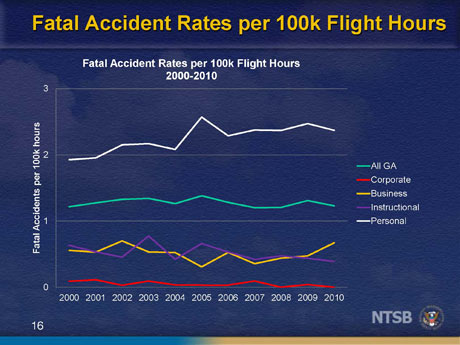August 27, 2012
As part of NBAA’s effort to get business aviators to think differently, in a much more engaged way, about their training, the Association held a pilot training symposium on Aug. 22 at the headquarters of the National Transportation Safety Board (NTSB).
Although the accident rate for business aviation has been very low for several years, a number of accidents have occurred in which pilot training and performance have been identified as factors, indicating that perhaps changes in the approach to training are warranted.
NBAA’s Safety Committee, which hosted the symposium, has worked over the past year to address these concerns, not only focusing on identifying potential shortfalls, but also proactively looking for better ways to improve training and enhance safety. One of the committee’s approaches has been to look at programs used in other segments of the industry, such as the airline-focused Advanced Qualification Program (AQP) for FAR Part 121 and 135 operators, as well as improving the fidelity and realism of simulators.
The symposium focused on work already completed by NBAA’s Safety Committee, along with a plan for tools and guidelines to assist business aviators in advancing their own training programs.
Richard Walsh, chair of NBAA’s Safety Committee, said training is the key to mitigating risk and improving safety, but added that it starts at the individual level.
“We need to change attitudes about training– it’s not a passive event,” Walsh said. “Unless pilots are committed to learning, training programs will not be successful.”
Steve Charbonneau, head of the pilot-training project, said one identified weakness was a gradual shift in focus from learning to just recertification.
“We need an education system designed to develop aviation skills, including aircraft handling, airmanship, flight deck resource management, risk management and decision-making,” he said, adding that there must be a learning environment that aligns with a company’s safety management system.
Presentations suggested several different ways to improve the quality of training, such as distance learning and simulator use, which would also have the benefit of not unduly elevating cost and time spent.
Dr. Earl F. Weener, a member of the NTSB, said general aviation safety was at the top of his organization’s priorities, and he gave numerous examples of real-life accidents that could have benefitted from training or adherence to standards. He highlighted the excellent safety record of flights categorized as “corporate/executive,” and focused on how to improve training for segments of the industry, such as owner-flown business aircraft, that do not always have robust safety systems to support pilots’ decisions.
The day closed with a panel discussion between Dr. Weener, the members of the NBAA Safety Committee and the audience.
The committee’s work is not complete, as the group will continue to strive to be a “center of expertise” on a wide range of business aviation safety matters, while providing implementable products, tools and services in order to enhance a positive safety culture within the industry. The committee’s work will focus on:
- Identifying business aviation pilot skills and standards
- Guides for operators and training providers to assist in the development of robust training programs
- Proposing regulatory and policy changes that would improve the training value proposition.



 International Business Aviation Council Ltd.
International Business Aviation Council Ltd.